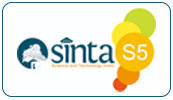THE USE OF COLLABORATIVE TECHNIQUE IN TEACHING SHORT STORY AT THIRD GRADE STUDENTS
Abstract
Teacher should utilize collaborative strategy when teaching short story writing since short story writing requires more stages to practice. The following are the objectives of this study: (1) to look into the process of teaching a short narrative using a collaborative approach; (2) to look into the process of teaching a short tale using a collaborative approach; (3) to look into the effects of employing collaborative learning to teach short stories; and (4) to look at the benefits of the teacher's method of teaching a short tale to third-grade pupils through collaborative tehcnique. This study used qualitative research with third-grade bidikmisi scholarship students at STAI Brebes as participants. Data was collected by observation, interview, and documentation. The data for this study came from a teacher and pupils in the third grade at STAI Brebes' bidikmisi scholarship program. The findings of this study revealed that employing collaborative writing in the classroom to teach short stories resulted in (1) students being able to develop their short story writing skills; (2) students were able to write a short story in Indonesian; (3) students were able to translate a short story into English; (4) students learned new vocabulary; and (5) students were able to assess grammar in the classroom. The benefits of teaching short stories through collaborative technique were as follows: (1) students were able to engage in social contact; and (2) students were able to explore ideas in short story writing.
Keywords
Full Text:
PDFReferences
Agusta, D. (2015). Improving Students Ability in Writing Narrative Texts Using Short Animated Stories at Class Third C of SMPN 2 Sanden, Bantul in the Academic Year of 2013/2014. Unpublished Thesis. Yogyakarta: Universitas Negeri Yogyakarta.
Alvarez, at al. (2011). The Value of Feedback in Improving Collaborative Writing Assignments in an Online Learning Environment. Studies in Higher Education. Taylor & Francis online.
Alwasilah, C. & Suzanna, S. (2013). Pokoknya Menulis. Bandung: PT Kiblat Buku Utama.
Alwasilah, C. (2014). Islam, Culture and Education. Bandung: Remaja Rosda Karya.
Aminuddin. (2004). Pengantar Apresiasi Karya Sastra. Bandung: Sinar Baru Algensindo.
Amir, Z. at al. (2011). Blogs in Language Learning: Maximizing Students Collaborative Writing. Journal procedia-social-and-behavioral-sciences. Science Direct. Elsevier
Arikunto, S. (2006). Prosedur Penelitian Pendekatan Praktik. Jakarta: Rieneka Cipta.
Bahari, M. F. V. (2017). The Effectiveness of Collaborative Writing Method Towards Students Writing Ability of Third Grade at SMPN 3 Kedungwaru in the Academic Year 2016/2017. Unpublished Thesis. English Department. Faculty of Tarbiyah and Teacher Training. State Islamic Institute (IAIN) of Tulungagung.
Barton, W & Cummings, R. (2011) Wiki Writing: Collaborative Learning in the College Classroom. The University of Michigan Press.
Ellis, R. (1997). SLA Research and Language Teaching. New York: Oxford University Press.
Gordon, J. B. & Kuehner, K. (1999). Fiction: The Elements of Short Story. NewYork: McGraw Hill.
Gousseva-Goodwin, J. V. (2000). Collaborative Writing Assignments and On-line Discussions in an Advanced ESL Composition Class. Unpublished Doctoral Dissertation, The University of Arizona, USA.
Guasch, T. at al. (2013). Effects of Feedback on Collaborative Writing in an Online Learning Environment. Distance Education. Taylor & Francis online.
Harmer, J. (2003). The Practice of English Language Teaching. London: Longman.
Harmer, J. (2004). How to Teach Writing. Pearson: Longman.
Hyland, K. (2009). Teaching and Researching Writing. UK: Pearson
Langan, J. (2006). English Skill: Third Edition. New York: McGraw Hill Higher Education.
Moelong, L. (2013). Metodelogi Penelitian Kualitatif (Edisi Revisi). Bandung: Remaja Rosda Karya.
Murphy, T., & Jacobs, G. M. (2000). Encouraging Critical Collaborative Autonomy. JALT Journal, 22(2), 228-244.
Murray, D. E. (1992). Collaborative Learning as Literacy Event: Implications for ESL Instruction. In D. Nunan (Ed.), Collaborative Language Learning and Teaching (pp. 100-117). Cambridge: Cambridge University Press. Murphy, T., & Jacobs, G. M. (2000). Encouraging Critical Collaborative Autonomy. JALT Journal, 22(2), 228-244.
Noor, J. (2013). Metodologi Penelitian. Jakarta: Karisma Putra Utama
Pramono, J. E. (2014). The Effectiveness of Collaborative Writing Method in Teaching Writing at MTs Assyafiiyah Gondang. Unpublished Thesis. English Department. Faculty of Tarbiyah and Teacher Training. State Islamic Institute (IAIN) of Tulungagung.
Randal, H. (2004). Literacy an Introduction. Edinburgh: Edinburgh University
Ramadhani, A. R. (2017). The Effect of Collaborative Writing Strategy on Students Achiement in Writing Recount Text in Mts Alwashliyah Tembung in The Academic Year 2016/2017. Unpublished Thesis. Scholar degree. State Islamic University of North Sumatera Medan.
Richard, K. (2000). Literacy and Language Teaching. New York: Oxford University Press.
Reagen S. B. at al. (1994). Writing With: New Directions in Collaborative Teaching, Learning, and Research. State university of New York Press
Robinson, B & Schaible, R. M. (2010). Collaborative Teaching: Reaping the Benefits. College Teaching. Taylor & Francis online
Septiana, R. (2016). Improving Students Analytical Exposition Text Writing Ability Through Collaborative Writing Strategy in Second Year of SMA DCC Global Bandar Lampung.Unpublished Thesis. Scholar degree. Universitas Lampung
Silalahi, U. (2006). Metode Penelitian Social. Bandung: Unpar
Sugiyono. (2009). Metode Penelitian Pendidikan (Pendekatan Kuantitatif, Kualitatif, dan R & D). Bandung: CV Alfabeta.
Suharianto, S. (2005). Dasar Dasar Teori Sastra. Semarang: Rumah Indonesia.
Sumardjo, J. (2007). Catatan Kecil Tentang Menulis Cerpen. Yogyakarta: Pustaka Pelajar.
Suwantarathip, at al. (2014). The Effects of Collaborative Writing Activity Using Google Docs on Students' Writing Abilities. Turkish Online Journal of Educational Technology. ERIC
Wahyuni, S. (2017). Improving Students` Ability in Writing through Collaborative Writing Strategy at the Islamic Junior High School Muhammadiyah 01 Medan. Unpublished Thesis. Scholar degree. State Islamic University of North Sumatera Medan
DOI: https://doi.org/10.37598/pjpp.v8i2,%20Oktober.1085
Refbacks
- There are currently no refbacks.

Pedagogik: Jurnal Ilmiah Pendidikan dan Pembelajaran Fakultas Tarbiyah Universitas Muhammadiyah Aceh by Fakultas Agama Islam Universitas Muhammadiyah Aceh is licensed under a Creative Commons Attribution 4.0 International License.
Based on a work at http://ejournal.unmuha.ac.id/index.php/pedagogik.









